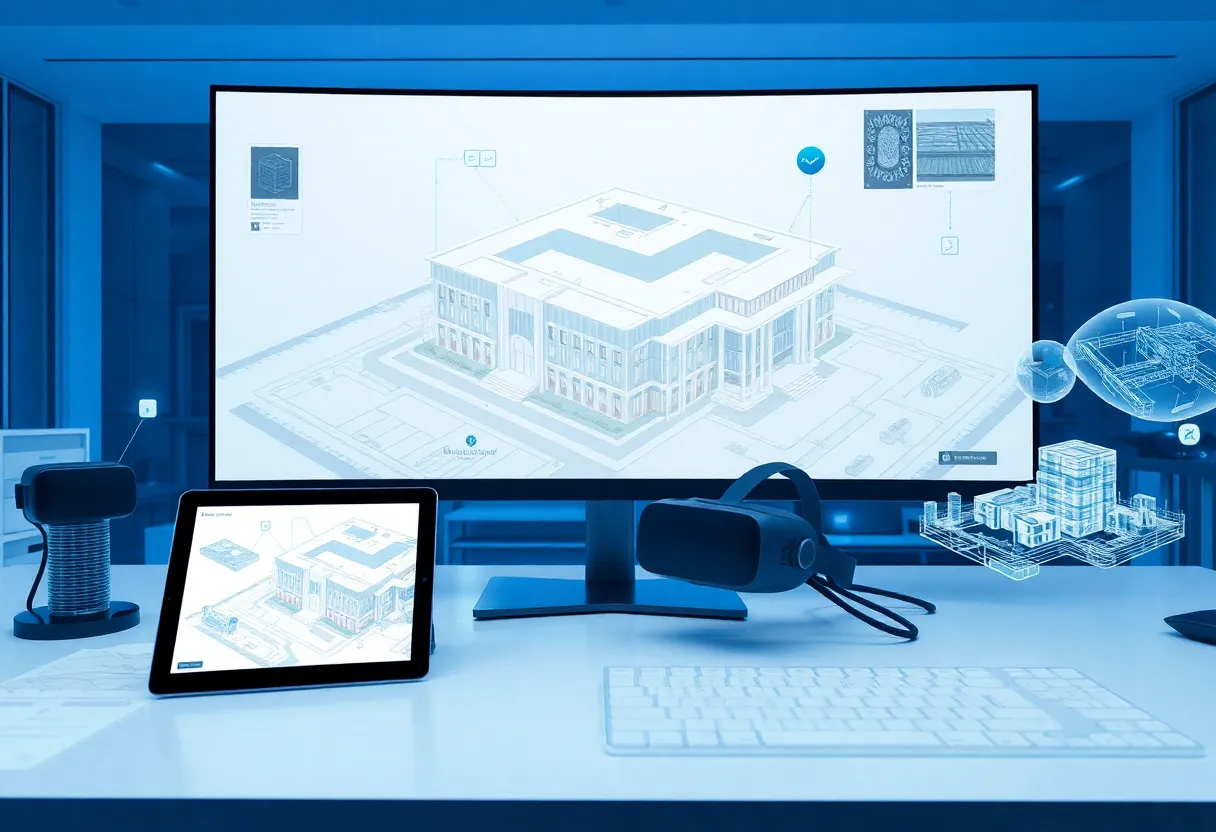Global, August 13, 2025
News Summary
Revizto has rolled out a Unity-built, cross-platform BIM collaboration layer designed to federate very large models and centralize coordination and issue management. The cloud-enabled platform fuses 2D drawings into 3D model views so markups remain spatially linked, supports real-time clash detection and issue tracking, and handles point clouds and lightweight mesh workflows. Native desktop and mobile apps plus a web-based issue tracker enable offline and browser access. Optimization reduces polygon and texture weight to keep giga-models interactive, while plugins and imports preserve interoperability with common AEC authoring tools.
Unity-based, cross-platform BIM collaboration platform expands reach for large AEC projects
A cloud-ready, Unity-engine application now serves major architecture, engineering and construction teams by combining 2D drawings, 3D models and field data into one coordinated workspace. The platform is built to handle very large federated models, support real-time coordination and deliver issue tracking across desktops, tablets and phones.
What it does and why it matters
At its core the application is a cloud-based BIM coordination, collaboration and issue manager. It fuses 2D drawings into 3D model views so teams can see plan and section drawings aligned automatically with the BIM geometry. That fusion enables teams to find and manage clashes, assign and track issues, prepare scheduled reports and produce dashboards that are printable to PDF.
The platform is designed to be cross-platform and open. It uses a lightweight portion of the Unity game engine to deliver a simple, interactive interface while consuming heavy 3D data. Developers report that the product uses about 7% of the Unity engine and that an engineering team built roughly seven million lines of code on top of it. The goal is to offer one federated view—what the company calls a single source of truth—for big projects without forcing teams to abandon their native authoring tools.
Scale and data handling
The software positions itself to support the world’s largest BIM and infrastructure jobs. Company figures show the platform has consumed more than 280 terabytes of project data to date and includes optimization techniques aimed at reducing polygon counts and image sizes so even giga-models remain navigable. Recent additions include full point cloud integration and support for meshes and OBJ inputs, with the note that converting raw point clouds to lighter OBJ files requires third-party tools. Using meshes or OBJ can drop storage needs to only a small percentage of the original point cloud size while preserving coordinate alignment.
Formats, interoperability and openness
The product is OpenBIM-oriented and platform agnostic. It supports direct imports and plugins for many common AEC authoring platforms, including Revit, Navisworks, AutoCAD, Civil 3D, SketchUp, ArchiCAD, Vectorworks, Rhino and Tekla, along with mesh and OBJ workflows. This openness is designed to let owners, contractors and consultants work together without forcing a single closed format on every participant.
How teams use it
Users access features in several ways: a native desktop app for Mac and Windows, native mobile apps for iOS and Android, and a web-based issue tracker that runs in modern browsers on Mac, Windows or Linux. The company positions itself as a cloud-era app—leveraging cloud services for delivery and collaboration but keeping core functions in desktop and mobile clients rather than being strictly cloud-first.
Key collaboration features include a 2D/3D hybrid viewer where markups and stamps are spatial objects visible in plan, section and 3D views. These markups carry metadata such as issue properties, tags and assignees, and are bi-directionally linked so a markup placed on a drawing stays positioned correctly in 3D views. QR code support links physical locations to issues in the model for field use.
Coordination, clash detection and reporting
The platform includes real-time coordination tools, advanced clash detection for modeling checks and a searchable issue manager used to prepare filtered reports and dashboards. The user interface and workflows emphasize simplicity so field staff and non-technical stakeholders can adopt the system quickly.
Devices, VR and roadmap
The platform runs on common VR headsets for immersive walkthroughs and lists augmented reality on the roadmap, targeting tablets first. Development teams gather user feedback through community groups and chat channels to guide feature priorities.
Market position and customers
The product is not promoted as a Common Data Environment or an authoring tool. Instead, it is pitched as a federated BIM coordination and collaboration layer that works with many authoring systems. About 60% of core customers are general contractors; the rest include owners, engineers, architects and facilities management teams. Geographic distribution of users is roughly 30% Europe & Middle East, 30% Asia-Pacific, and 40% the Americas. The platform is used across sectors including very large infrastructure projects and airport facility work used for QA/QC and facilities management.
Pricing and packages
Commercially, the product offers different packages. Contractors and large owners often get single licenses with project-based pricing and unlimited users on a project. Architects and engineers typically buy model-based packages or receive discounted access when included on projects commissioned by owners or contractors.
Strategy and industry context
Company leaders stress openness and interoperability, noting that global markets accept open standards differently and that no one vendor can serve every need worldwide. The platform aims to lower rework, centralize communication and bring BIM intelligence into the review and construction space, while staying focused on collaboration and coordination rather than on authoring or full model checking.
Frequently Asked Questions
What is this BIM collaboration platform?
It is a Unity-based application for federating 2D drawings, 3D models, point clouds and site photos into a single coordination workspace that supports issue tracking, clash detection and reporting.
Which devices and operating systems are supported?
Native apps run on Mac and Windows desktops, iOS and Android tablets and phones. A web-based issue tracker works in modern browsers on Mac, Windows and Linux. VR headsets are also supported for immersive navigation.
What file types and authoring tools are supported?
The platform integrates with many authoring tools and formats, including Revit, Navisworks, AutoCAD, Civil 3D, SketchUp, ArchiCAD, Vectorworks, Rhino, Tekla, meshes, OBJ and point clouds (with third-party conversion for some workflows).
Can it handle very large projects?
Yes. The platform claims to handle giga-scale models using optimization techniques and has processed hundreds of terabytes of project data. It emphasizes lightweight, high-fidelity model equivalents for performance.
Is it a Common Data Environment (CDE)?
No. The product focuses on collaboration and coordination across federated models. It is designed to complement CDEs rather than replace them.
How is pricing structured?
Pricing is offered in packages: project-based and unlimited-user licenses for contractors and owners, and model-based or discounted plans for architects and engineers.
Key features at a glance
| Feature | What it does | Platforms / Formats |
|---|---|---|
| 2D/3D fusion | Matches drawings to model sections and plans; markups remain spatially placed | PDF, DWG, native model viewers |
| Issue manager | Real-time tracking, assignments, tags, reports and dashboards | Web, desktop, mobile |
| Clash detection | Advanced modeling coordination checks | Model imports from major authoring tools |
| Point cloud & mesh support | Full integration with workflows that can include OBJ and meshes for size reduction | Point clouds, OBJ, meshes (conversion may require external tools) |
| Cross-platform delivery | Native apps and web tracker, VR support and AR planned | Windows, Mac, iOS, Android, VR headsets, modern browsers |
| Open integrations | Plugins and imports for many AEC authoring systems | Revit, Navisworks, AutoCAD, SketchUp, ArchiCAD, Rhino, Tekla, etc. |
| QR code linking | Connects physical locations to model issues for field use | Mobile devices |
Deeper Dive: News & Info About This Topic
Additional Resources
- Architosh: Inside Revizto — Global dominance with open BIM coordination
- Wikipedia: Building information modeling
- GeoWeek: Revizto — a look into the future of 2D/3D data fusion and collaboration
- Google Search: Revizto 2D 3D data fusion collaboration
- BBC News: Business coverage (related resource)
- Encyclopedia Britannica: Unity (game engine)
- BBC Somali: Aqoon-Guud (related coverage)
- Google News: Revizto
- Revizto (official site)
- Google Scholar: building information modeling clash detection
Author: Construction NY News
The NEW YORK STAFF WRITER represents the experienced team at constructionnynews.com, your go-to source for actionable local news and information in New York and beyond. Specializing in "news you can use," we cover essential topics like product reviews for personal and business needs, local business directories, politics, real estate trends, neighborhood insights, and state news affecting the area—with deep expertise drawn from years of dedicated reporting and strong community input, including local press releases and business updates. We deliver top reporting on high-value events such as the New York Build Expo, infrastructure breakthroughs, and cutting-edge construction technology showcases. Our coverage extends to key organizations like the Associated General Contractors of New York State and the Building Trades Employers' Association, plus leading businesses in construction and real estate that power the local economy such as Turner Construction Company and CMiC Global. As part of the broader network, including constructioncanews.com, constructiontxnews.com, and constructionflnews.com, we provide comprehensive, credible insights into the dynamic construction landscape across multiple states.





